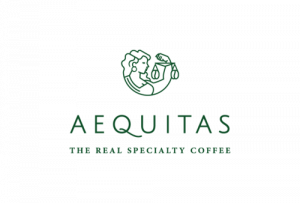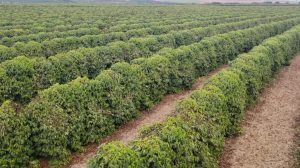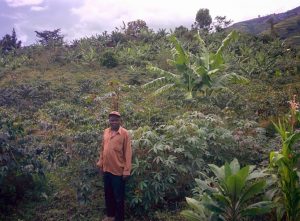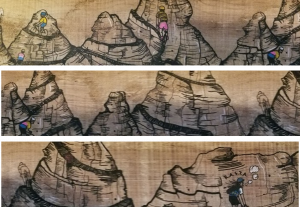If you would like more than 8 samples, please contact a trader directly.
Cart
A trader will contact you with shipping and payment options after checkout. Please note: free samples are provided to commercial roasting businesses only.
“It felt kind of funny”. My first few days back from my first time in Brazil, this is how I tried to describe my experience. “It was familiar. Yet totally different.”
Food is relatable, so I start by describing the mixture of queues, customary and new, that make Brazilian food a masquerade of the familiar. Beautiful, bountiful breads I later learned are made with manioc or cassava flour instead of wheat [1]. Pizza is popular, thank you, but only to be eaten with a fork and knife if you please. Peppers; you’ll find peppers galore – sweet, though, none of them are spicy. And you’ll walk into a random road-side gas stop to find it seats 200 people and serves up top-notch BBQ. Even the local rum, cachaça, it tastes like rum you know … only with a distinct ‘fresh, green, sugar cane’ flavor [2].
Or take the landscape, contorted cerrado trees cut by straight rows of coffee that ran out over the horizon. It was a complete cross between an African Savannah and Iowa corn-field.


Or listen to the stories – familiar formulas with totally different denominators.
I traveled with urban-educated farmers in their 30s, each of them fresh back to the farm and in a generational struggle to get their parents to take specialty seriously. Each teaming up with agronomists, Q-cuppers and one another to make the most out of whatever leash they’ve been given to surf the third wave. Running experiments, reading articles and developing specialty brands while managing the day-to-day responsibilities (and change of pace) that comes with being back on the family farm.
And I met their parents, Japanese-Brazilian cowboys, and some of the region’s first settlers. Proud to send their children to college, and even more proud that they chose to come back. Stern-faced and straight-laced, they prefer the tried and true ways of how things have been done…but you may still find a Brittany Spears cassette hidden away in their car.
It was a mash-up of vignettes from the America Midwest with scenes from Hollywood’s Grease, imposed over How The West Was Won. It is the story of many family businesses and entrepreneurs that I know, of many Americans in coffee, complete with a road trip outfitted with Brazilian chicharrons and an Alabama Shakes soundtrack.
The effect was disorienting, and by the time I got to the farms I was halfway to dizzy. Coffee, at least, finally something familiar to me.
Except it wasn’t.
I saw farms absolutely thriving without a sliver shade in sight, yet chock-full of life.
I met twenty-foot tall harvesters that treated trees more gently than any but the most careful of hand-pickers.
I watched top quality specialty coffee set out to dry, constantly being turned with amazing loving care and attention. By tractors.
I met farm workers who have more rights than Walmart employees, and farmers with 30+ years of experience managing the world’s most modern coffee farms … while they were tasting their coffees for the very first time.
I saw vegetable coolers being used to experiment with cold fermentation, and living libraries of new varietals, designed in the lab for performance in the cup. I saw coffee grown at a scale I’ve never seen before, and experimentation at the nano-lot level that I never thought possible.
As I said, it all felt kind of funny. Conflicting, unsettling even. I couldn’t put my finger on it until I remembered a design term that described my feeling fully – the uncanny valley.

The uncanny valley refers to renderings of humans which appear “…almost, but not exactly, like real human beings elicit uncanny, or strangely familiar, feelings of eeriness and revulsion in observers” (thanks Wikipedia). Somewhere past cute and into creepy – I think of the puppets from Team America.
In the same way everything in Brazil was close to how I expected it to be, but just different enough to be unsettling. That funny feeling I felt was just all kinds of bias leaving my body. Bias which was getting in the way of me seeing specialty in Brazil for what it is and what it is coming to be.
This bias is a gap that stands between Brazil and specialty. So small you can skip it if you know where to step. But with conventions so deep that you can fall right in if you don’t know where to look. It is why older generations in Brazil find it hard to believe that specialty is the real deal. And why U.S. specialty balks at the idea of Brazilian micro-lots.
But I came to see Brazil as a serious source for top-end specialty. There is momentum and mass building behind quality in Brazil, right now, so obvious as to be undeniable. As proof I’ll point to the people I met who are pushing top-end coffees to new heights, using infrastructure and tools unavailable to farmers elsewhere in the world. I am excited to watch a new crop of farmers as they take their farms forward in generational strides, every harvest pushing back the horizon of what’s possible with Brazilian specialty.

So now I describe my trip as one through an uncanny valley. A personal journey to the belief that the future of Brazilian specialty is near, here, even, if only we will get out of the way. And if you have the patience, my good readers, read on and I’ll tell you how I got here.

Our story starts with one woman, Yuki Minami. That’s her pictured between Maya and myself in the photo above. Without her we wouldn’t be in Brazil. But hers was a mission so aligned with ours, and a personality so compatible, that because of her we were inspired to study up on Brazil to see where were could pitch in, and if we could find happy homes for her coffee.
This was 2017/2018, and Yuki’s first export as Aequitas Coffee.
For readers new to this story, Aequitas Coffee is equal parts educator and exporter. It is Yuki’s vehicle for helping fellow producers to become aware of what they have and their options for participating in specialty.

The normal exporter – farmer relationship in Brazil is paternal, patriarchal even. It’s not common for farmers to know where their coffee goes, how it is priced or if it could score well enough to break out of the top-shelf designation of Sc 16+ 2/3 SS FC. And while that’s the premium price a farmer can get, it’s still only top of the heap for commodity coffees, and not at all how specialty is traded. So, for Aequitas to invite us down to host a workshop that gives feedback, talks pricing strategy and discusses trends with producers – well let’s just say that this was a first in many ways.
Yuki’s mission is to empower farmers with knowledge of what they have and how they can compete in this game we call specialty. She plays the game well and her work lives up to her word; Yuki does so much to support her community that even she’d blush if I listed all that I saw here in one place. Her primary communities are those around her farm in São Gotardo, fellow members of her Japanese-Brazilian community in the greater Cerrado Minero region, and women in coffee anywhere.
Her style is more to connect, collaborate, facilitate, educate and lead by example. She’s the type who needs to eat her weight every lunch so that her body can keep up with the energy within. She’s a researcher at heart, I think, because she takes time to get smart but when she moves, but when she it’s towards long-term objectives barely on the horizon. If you can’t tell, I’m a fan.

Still, the last thing a fish will discover is water. And even as Yuki raises the bar in Brazil her work is overshadowed by stereotypes that stand between Brazil and specialty in the minds of her parents, colleagues and customers.
With few exceptions, we still see coffee from Brazil as bulk, mechanized, a commodity. Responsible for supplying nearly half of the world’s coffee, and by far the biggest influencer on price – we have reason to think Brazil and bulk in the same sentence.
I mean, the one time I asked for a sample of a Brazilian 2/3 SS FC I was laughed at – apparently this is like asking to taste a Big Mac before buying it. [3]
And because interactions like of this we assume that farming in Brazil is unsustainable, and incapable of producing specialty. Even as I met people, saw farms and tasted coffees to the contrary, this base assumption somehow held on, impacting what I was looking for and what I saw.
My resume is working with smallholders in places more remote than Minas Gerais. Places where we measure harvests in terms of kilograms cherry per tree, not in liters per hectare as they do here in Brazil.
Sidebar: I smile when I think back on just how difficult it was to show Yuki’s father what a coffee farm in Africa looks like. After stumbling over conversions of trees per hectare and liters to kilograms I resort to showing photos. But even when looking at a photo of a small Ugandan shamba one of the farmers asked ‘so, where’s the coffee’?


“You see”, I said, “before running off to Ethiopia to get those prices remember that they only get 1.5 – 4 KG cherry per tree to your 9 – 12”.
When working with smallholders the best we can do for quality is to encourage healthy trees through good agricultural practices, backed up by selective picking and proper drying. They simply are not able to separate by varietal or experiment with post-harvest processing. In contrast, here in Brazil, coffee is harvested and dried mechanically; efforts to improve quality are in genetics and fermentation techniques.
In the end it all makes a difference – genetics, harvesting, processing and drying. But to-date I had only been trained to the see upstream indicators of quality associated with smallholders[4] and not what was possible when we put our scientists to the task. I found myself looking for what I knew instead of into that which was new. And the more I actually looked the more I liked what I saw.

There’s harmony to be found in the relationship between proud farmers, honest leaders and strong organizations. I appreciate the craft of feeling the soil to judge its health, or in knowing fermentation by the straightness of a stick. I grew up in coffee rubbing parchment to measure moisture or biting on a bean for the same, and still do this while my moisture meter takes its time to tare. I see integrity in varietals that are heirloom and native to the region. And wisdom baked-in to how each family selects for the right shade of red, then navigates the complex web of relationships, business and personality that guides how coffee is processed from there.
But there’s also something to be said for the modern means we have for quantifying, measuring, tracking and influencing the world of variables that impact quality. With enough control, coffee can be closer to a clean science than a messy negotiation between nature, culture and environment.
I love the mess, don’t get me wrong, and I always will. But I wasn’t even really aware that there was another way until I started seeing things from Yuki’s point of view. She has an eye for artistry, absolutely, but she paints with pragmatism.
She has never said as much, but the mission of Aequitas is empowerment through education, so I imagine that to Yuki learning is what is most important. And with learning as priority #1 the rest is easy to breakdown. To learn you need the ability to track. Tracking requires taking measurements over time. For measurements you need consistency and controls. For time you need a plan and some patience, cause there’s just never enough time.
Which is why Yuki, Edson and everyone in this generation seems ravenous in their hunt for knowledge. Yuki’s curiosity is as big as her appetite, and the world a buffet of examples she can learn from. The tastiest of notions make it back to her cupping table via the living laboratory that is her farm, where she has the control to try for consistency, to track and improve over time.

From the way she talks about it, Yuki sees mechanical dryers not as a short-cut, but as additional tool that helps her practice her art which is quality. Through her eyes I can see the daily danger that is dew, and the beauty of watching coffee dry in a straight line. I see the possibility that comes with control.[5]
Where I once saw rows of technified coffee and thought, ‘hmm, no shade, no birds, poor soil, unsustainable’. Yuki sees life in soil that otherwise would be too acidic to support more than sparse savannah. She sees the immense amount of effort her family puts into maintaining the land, and points proudly to the white streaks of calcium that line the road in to town, without which nothing would grow.[6]
Yuki grew up walking along the rivers, lakes and other permanently protected areas of their farm. She played in the forests that make up an additional, mandatory 20% of her family’s land. She’s spent time poking through the coffee trees and knows well the abundance of life they contain.
All the data points kept adding up, but my shift still seemed to click over at once. Emerging from the uncanny valley felt like shrugging off a heavy backpack or that moment when the sun escapes from behind a cloud.
It was the birds that did it.
Sereima and Jacu birds eating berries off the patio. Sparrows, swallows, kestrels and parakeets, owls and toucans. I’m not talented enough of an author to tell you what I mean by this, but if you lend me your imagination I’ll do my best to take you there.
—
Driving through Yuki’s coffee farm was like racing through a healthy hedge maze. It had been a long day, my head full with all the all aforementioned information. Whipping past rich green leaves, vibrant red and yellow berries; life bursting from the trees up to the point of pruning up living walls of green stretching 12’ overhead.
With such straight lines, from a distance, it’s easy to forget that it’s still just nature in here.
Until we are in there and an orchestra of chirps trumpet in from the left or right, heralding a flurry of black and blue (and yellow, and red) as tiny birds blast out from the branches and stream into the alley between. They join in the middle of the row, a confetti cannon of chaotic colors leading your way through the hedgerows, staying just in front of your windshield like flying toasters in reverse.
We chase them down row by row until we until we finally come across the harvester, a 20’ tall needle in a 120 hectare haystack. One of her playmates from back in the day, Almir, was driving a harvester.
We hopped on.

This was my first encounter with a harvester and, quite frankly, I’d been anti. I’d assumed them to be incapable of selective picking, and harmful to trees. But by the time I hopped off I wanted my very own.
I looked up and saw not a monstrosity, but a beautiful, modern machine designed to vibrate berries off of branches as gently and efficiently, as possible. I looked back and saw a row of happy trees, slightly disheveled but better off for it. I got exciting hearing Yuki talk about the technology progressing every year. About how you take your quality map into a harvest plan, which informs how you set arm placement, vibration and rotation speed … for example. Needless to say I was impressed, and asked for the specs on her Jacto K3 Millenium[7].
Ears still buzzing, we made our way over to the drying patios where we get out of the car and took a knee to look for pooling after a recent rain. Even with our attention down we could not help but notice the toucan perched up above. This was the final straw, where I made up my mind that I’d had it all wrong.
While there’s no arguing with the Smithsonian standards for Bird-Friendly farms, and that these farms would not qualify.[8] Farms which do not qualify are not inherently unfriendly to birds.
But if you go at dusk you may see two owls, like we did, just waiting for a meal. Or hummingbirds darting in to the irrigation line, looking for a drink. If you have a farm dog you can smile as they bound through the coffee bushes, disappearing for a moment only to produce squawking grouse chased from their perch. If peregrine falcons can take roost in downtown Chicago it should not be a surprise to see Toucans thrive here in Brazil.

The sun sets early here; it’s already getting lower when Yuki suggests we break for coffee. She drives us up to a ridge within the coffee farm that overlooks a newly planted plot, short enough that we can see all the way west. There’s a trailer here, set up as a lounge. A long picnic style table runs down the middle with water, a stove and coffee setup.
This trailer moves around the farm as a break-station for workers. A bit nomadic, but in this case, totally romantic. Looking out over the coffee fields, hearing nothing but the buzz of bees and rustling of leaves, I would have fallen in love with any coffee Yuki wanted to serve in this setting. But it was this juicy yellow bourbon, which we drank to the last drop, making another before heading back to the farmhouse.

We arrived there at 5:01. I remember the time because as we pull up motorcycles are pulling out, and Yuki explains ‘5:00, time to go home’. While land is wealth, and ownership associated with the political right, the left has been in power for long enough that farm workers have more rights in Brazil than they do in America, or on any other farm I’ve seen. The amount of times I heard “there’s a machine for that”, is one reason why – most labor on the farm is mechanically assisted. But it’s also in the relationships. Due to the diversity of crops allowed in the São Gotardo region most farm workers were from the community and there year-around.
São Gotardo grew to 30,000 people in under fifty years, yet receives an additional 20,000-30,000 more seasonal workers each year, in particular for the winter (July) carrot harvest. It is said that these workers are from the Maranhão region of northern brazil, though in truth they can come from anywhere. And
they are just some of the many ‘sem terra’, without land. This is a movement, associated with the political left, that represents the rights of many migratory workers and which encourages squatting as a strategy. It’s a real issue; like the US, Brazil’s history saw waves of immigrants coming in to settle land in large tracts. This leads to a large landed elite, as well as many (former slaves) who were not able to take part in this land grab.
Still, without coffee, today these workers from the north would be ‘sem emprego’, without jobs. Jobs which seem to be very organized and regulated. Not taking a side here, just rounding out a rather complex issue. Because, in fact, some argue that the reason you don’t see many small coffee farms any more is because labor is so well protected that most cannot afford to mechanize, comply and compete.
Regardless, the outcome is that those farmers who are left are competitive, and are just now turning their attention to specialty.
We leave São Gotardo,, and the Minas Cerrado region, to visit another farmer in Santo Antonio do Amparo. The story of Miriam is beautiful, and inspiring. It involves paint horses, funky fermentation, the dawn of Brazil’s organic movement and the mobilization of women in coffee in the support of women in coffee. That is to say that it is a story for another day.
We did not get to share about our visits with Edson or Maycon; partners in Aequitas and heart-warming people. You did not get to learn of Ana and her work at São Luiz Estate. About Renato or Maxwell; sharp, young Q-cuppers on the rise. Or about Camila’s research on the gastronomy of varietals. Suffice it to say that has a deep bench stocked with top talent. We have found great partners, and can only hope to be great partners in return.

Like Aequitas, we want suppliers to know what they have so that that they can compete, thrive and sustain in their commitment to specialty. But as Saturday morning cartoons taught me, ‘knowing is half the battle’. I add ‘only’, because on a long journey, halfway still leaves a long way to go.
Farmers are getting on the specialty train at every stop, but without an open-minded market they won’t have a ticket to ride. The other half of the battle, then, involves changing mindsets about how we in specialty think about Brazilian coffee. Starting with our own.
Towards this end I offer my journey through my own bias as example, and hope that it is useful in yours. But if you find yourself still questioning Brazil’s ability to get down with specialty, ask yourself this. How can coffee from a place with such passion fail to have heart? How can the world’s leader in coffee production, policy and research not have what it takes to execute at the upper end of what’s possible? How can generation of farmers with the heart, mind and hands for specialty – people like Edson Tamekuni (pictured above) – how can you expect them to sit back and not take part in their own future?
With a generation of people like Edson taking the reins US specialty buyers will be lucky to just hold on. Did you know that most of Brazil’s coffee goes to Europe (Germany), and that every auction sees Asia (Australia) taking the top? Did you know that the washed process was invented in Brazil, as were pulp-naturals? Farmers here have always adapted to what customers ask of them. It’s time we got their ear.
Still skeptical? That’s fine. Visit us at SCA 2019 in Boston where we will be making room for a cupping of Brazilian experimental lots. Tasting is believing, so put your skepticism in your pocket until then and come with an open mind and clean palate.

(mural from ‘King of Fork’ café in São Paulo)
[1] Which gives them the best of textures. Firm, chewy on the outside, fluffy in. I came back and made this Pao de Queijo recipe right away and found it quite good (I subbed half the shredded mozzarella for fresh, and used a top notch parm, which I think made a difference).
[2] A flavor that comes from distilling sugar cane juice directly, skipping the step in refinement that makes molasses
[3] 2/3 = the first number states how many defects are allowed; 2/3 is the cleanest commodity designation with maximum of nine secondary and no primary defects (which is close to the C2C standard of 0 primary and no more than 5 secondary)
SS = Strictly Soft; this is confusing, as technically it means lower altitude (less dense) beans, but in practice in means beans which are clean of rioy defect
FC = Fine Cup; a designation of cup quality
[4] Farming for quality as a smallholder: (1) Get to red ripes. (2) Plan for lot separation. (3) Dry slowly. Farmer for quality in Brazil (1) Know your genetics, (2) Quality mapping (lot separation plan), (3) Proper post-harvest processing
[5]Speed: 0.35 to 1.25 miles / hours.
Brake: 8 KG max (heavier brakes slow roll rotation, aka, the forgiveness of the harvester)
More information, and a 3D tour of the machine, available here
[6] SMBC certification requires adherence to the same standards for organic coffees, plus an additional requirement that 40% of the farm have shade cover
[7] We haven’t talked about this yet, but next year I want to see if Yuki would run experiments to see what happens in the cup when we modulate the drying curve over extended periods of time.
[8] Yes, Minas Gerais (translation; general mines) is a mining state, and the next town over has old quarries that bring all the calcium the soil in São Gotardo needs to support the State’s richest diversity of crops.